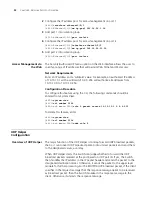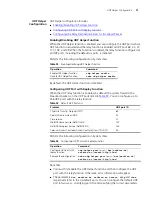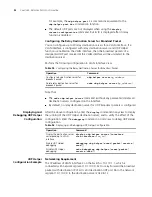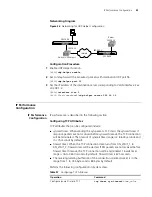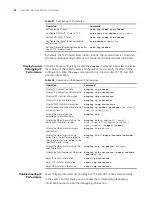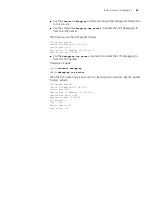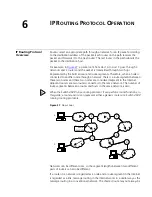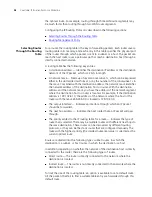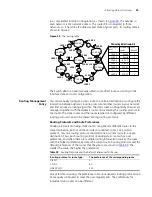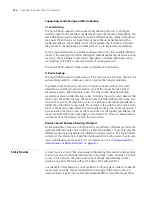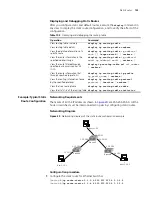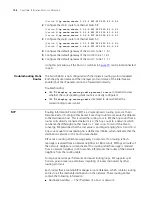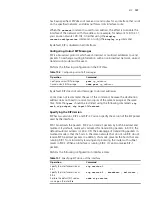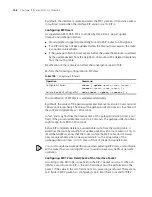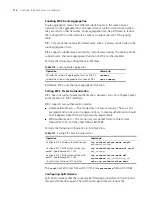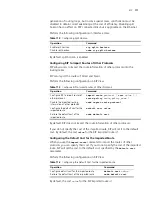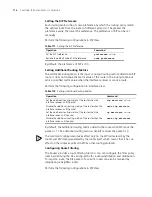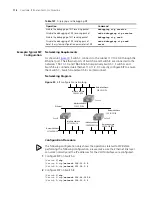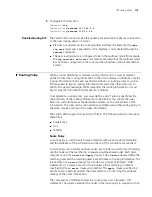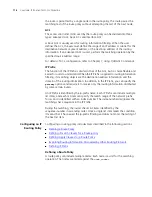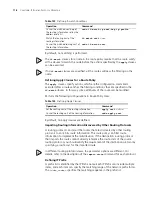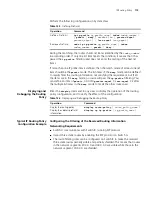
104
C
HAPTER
6: IP R
OUTING
P
ROTOCOL
O
PERATION
[Switch A]
ip route-static 1.1.5.0 255.255.255.0 1.1.2.2
2
Configure the static route for Ethernet Switch B
[Switch B]
ip route-static 1.1.2.0 255.255.255.0 1.1.3.1
[Switch B]
ip route-static 1.1.5.0 255.255.255.0 1.1.3.1
[Switch B]
ip route-static 1.1.1.0 255.255.255.0 1.1.3.1
3
Configure the static route for Ethernet Switch C
[Switch C]
ip route-static 1.1.1.0 255.255.255.0 1.1.2.1
[Switch C]
ip route-static 1.1.4.0 255.255.255.0 1.1.3.2
4
Configure the default gateway of the Host A to be 1.1.5.1
5
Configure the default gateway of the Host B to be 1.1.4.1
6
Configure the default gateway of the Host C to be 1.1.1.1
Using this procedure, all the hosts or switches in
Figure 29
can be interconnected
in pairs.
Troubleshooting Static
Routes
The Switch 4500 is not configured with the dynamic routing protocol enabled.
Both the physical status and the link layer protocol status of the interface are
enabled, but the IP packets cannot be forwarded normally.
Troubleshooting:
■
Use the
display ip routing-table protocol static
command to view
whether the corresponding static route is correctly configured.
■
Use the
display ip routing-table
command to view whether the
corresponding route is valid.
RIP
Routing Information Protocol (RIP) is a simple dynamic routing protocol, that is
Distance-Vector (D-V) algorithm based. It uses hop counts to measure the distance
to the destination host. This is called the routing cost. In RIP, the hop count from a
router to its directly connected network is 0; the hop count to a network which
can be reached through another router is 1; and so on. To restrict the time to
converge, RIP prescribes that the cost value is an integer ranging from 0 and 15. A
hop count equal to or exceeding 16 is defined as infinite, which indicates that the
destination network or the host is unreachable.
RIP sends a routing refresh message every 30 seconds. If no routing refresh
message is received from a network neighbor in 180 seconds, RIP tags all routes of
the network neighbor as unreachable. If no routing refresh message is received
from a network neighbor in 300 seconds, RIP removes the routes of the network
neighbor from the routing table.
To improve network performances and avoid routing loops, RIP supports split
horizon, poison reverse, and allows importing of routes discovered by other
routing protocols.
Each router that is running RIP manages a route database, which contains routing
entries to all the reachable destinations in the network. These routing entries
contain the following information:
■
Destination address — The IP address of a host or network.
Summary of Contents for 400 Family
Page 12: ......
Page 16: ...14 ABOUT THIS GUIDE ...
Page 58: ...56 CHAPTER 2 PORT OPERATION ...
Page 68: ...66 CHAPTER 3 VLAN OPERATION ...
Page 98: ...96 CHAPTER 5 NETWORK PROTOCOL OPERATION ...
Page 124: ...122 CHAPTER 6 IP ROUTING PROTOCOL OPERATION ...
Page 156: ...154 CHAPTER 8 ACL CONFIGURATION ...
Page 218: ...216 CHAPTER 11 802 1X CONFIGURATION ...
Page 298: ...296 CHAPTER 13 PASSWORD CONTROL CONFIGURATION OPERATIONS ...
Page 336: ...334 APPENDIX B RADIUS SERVER AND RADIUS CLIENT SETUP ...

